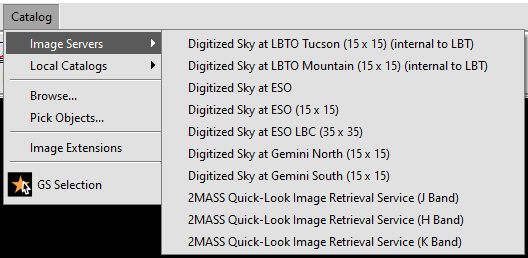Current Release Notes
OT 2025B is fully backwards compatible with the previous 2020A & 2022B version. OBs created with the 2020A & 2022B version can seamlessly be ingested into 2025B+ OT’s
2025B Version 1.1.0: September 03 2025
- Gaia DR3 catalog added
- Improved WCS transformation to support JWST, PanStarrs, and DES images
- Encrypted HTTPS connection to backend server
- Support for 64bit floating point precision images
- GCS-2 catalog removed
Listed below are known issues and bugs in this Public Release. Improvements to this software are on-going and despite our best efforts, all bugs are likely not known or characterized. If you find a bug, please contact the Q-Dev team at queue_dev@lbto.org.
Current Release:
Upgrades/Fixes to previous semester releases:
- Scripts for LUCI ADI observations can now be created via the OT without the need for manually editing the script.
- Selecting a subwindow for LUCI observations inserts pauses in the script for acquisition, similar to spectroscopic observations.
- Visualization for LUCI subwindows added to the Position Editor.
- A 1.2 mag offset the R-Band magnitude of an LUCI AO reference star is added to convert the R-Band magnitude to the WFS magnitude.
- LUCI AO patrol field has been remeasured and updated.
- Dimensions of the LUCI facility slits updated.
- Updated/added visualization for the LUCI GS patrol field. It now shows the 5″ warning area at the border of the patrol field. The GS area which is accessible from all dither position is outlined.
- LUCI G150 grating removed
- LUCI G040 grating added
- LBC optical image query size increased.
- Added a search for co-pointing and collimation stars to the LBC guide star selection.
- LBC dither pattern reordered
- LBC 3-pt tilted triangle dither pattern added
- Backwards compatibility for custom masks improved.
- LBC scripts for mixed-mode observations can now be created via the OT without the need for manually editing the script
- Observing conditions tab adjusted for AO observations
- Improved error handling and warning messages
- Increased width of the SPTree
- Fixed a bug with Dec 90° & -90°.
Known Issues:
- Warning and error messages for LUCI may not be up-to-date with rapid developments in modes and mechanisms offered. Unless explicitly stated, errors will not prevent script generation and can be safely ignored if you are confident with your set-up.Please check with your ISA if you have any concerns.
- Acquisition and spectroscopy blocks are not connected to lock Target coordinates, PA, or GS coordinates so that they must be identical. The same is true for LBCR and LBCB blocks which MUST have the same offsets.
- On Windows 10, no desktop icon appears after install. The icon does appear in the start menu.
- It is currently impossible to enter 0s as an Exposure Time for either MODS or LBC. Although it is common practice to do so for biases, it is not necessary in the OT. The scripts will simply ignore whatever exposure time you choose.
Known Bugs:
- Downloads of the library into Windows sometimes fail with the message shown below. One potential solution is to be sure to import the library directly from the default browser download folder rather than using any browser drag-and-drop feature. Another solution is to close and reopen the OT and try the import again.
- Potential catalog issue with the Position Editor. If your ‘Image Servers’ list in the Position Editor does not match the image below please see the FAQ page for the workaround.
- Intermittent screen painting issue across all platforms. The Telescope Mode and Position Angle drop-down boxes may disappear from the Target Tab. If this occurs, you will need to close and re-open your OT.
- Screen painting issues with Windows 10. If you are currently magnifying your desktop using the display settings under Windows 10 you may see cut off text on some OT screen. The ‘Observation’ / script creation panel, and the ‘Random‘ and ‘Grid‘ dialog boxes in the ‘Offset Sequence Component’ panel are known examples of where this may be seen. To correct this right click on your desktop and select ‘Display Settings’ from the menu. Set the ‘Change the size of text, apps, and other items’ slider to 100% and click on ‘Apply’. You may need to log out of your current Windows session and log back in again to have this correctly applied o the OT. If you find this makes the text on your screen too small to read then you might consider reducing your screen resolution under ‘Display Settings’, or using the ‘Magnifier’ desktop application.
- Error messages may appear inappropriately in MODS and LUCI sequence tabs even when no offset iterator is present:”You are offsetting along the dispersion direction and may be dithering outside the slit.”In these instances, please simply ignore this warning
- In LUCI, the OH1060 is not correctly identified as a cross-filter in the error handling software. You may receive warnings about exposure times and/or cross-filter combinations even when you have correctly selected this combination. Please ignore these warnings.
- You may see incorrectly triggered warning messages when completing MODS arcs or flats that suggest that the combination of filters and modes is non-standard. These warnings should only trigger for science; ignore any that appear for calibrations
- If the LBC image is too small it will impact the GS query.
- Selected zoom level in one instrument can affect FOV of other instruments in the Position Editor when switching between observations
- LBC Instrument Tab: When setting the Science Chip Readout, it is possible to put a minimum that is larger than maximum (don’t do this).
- LUCI Guide Probe geometries are not high fidelity (missing fold mirror shadow). Additional geometry will be added in the future.



